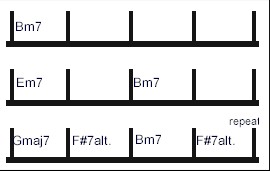Scroll through the lesson and click on notation/video/audio links to load the interactive players.
Please subscribe to get full access to all lessons for only $7.95/month PLUS 1 week free trial.

Riff Interactive lessons are
LESS expensive and
MORE interactive than alternatives!
More Info
|
|

Improvising
101
Lesson
4
Lyle: In the past 3 lessons you've been
introduced to several different techniques to help you improvise over common jam
situations. Another good technique to keep in mind is to structure and arrange
the flow of your improvised solo. Let's say you had a 12 bar blues progression
to solo over. You'll want to have a good start and have even a better finish to
your improv. Listen to this short example of a 12 bar blues solo.
Lyle:
This is in the key of B minor. The solo starts on the root note of the
progression, B. Notice how the flow of the solo slowly builds higher in pitch
and excitement until it reaches the end and hits the last note, high B. Solo 1
peaks at the very last note, a high B note. This is a common and simple way to
arrange an improvised solo. Start low and work your way up higher in pitch and
excitement.
Lyle: Learn solo 1 or improvise your own solo,
then play along to this looping jam track:
Lyle:
This next example is like solo 1 but instead of peaking the solo at the end,
you'll peak a couple measures before, then run back down to where you started.
Lyle: These two solos are great examples to help
you model your own improvisations. Always build your solo by moving higher in
pitch. You don't need to play fast licks, just move higher up the scale or neck
position. Remember to either peak your solo just before the end or save the peak
for the very end.
Lyle: The next technique to help you improvise
with is what I call the 50/50 technique. Place yourself as the listener of a
good solo. If the soloist were playing lick after lick of familiar licks without
much variation, as the listener, your attention level would drop. However, if
the soloist played familiar licks mixed up with unfamiliar licks, your attention
level would increase because what he was playing was unpredictable to your ears.
Playing simple familiar licks (predictable licks) mixed up with unfamiliar licks
(unpredictable licks) is what I call the 50/50 technique.
Lyle: Simply put: Half the time, play predictable
licks, the other half of the time play unpredictable licks. Listen to solo 3.
You'll hear this technique in use.
Lyle: Notice how the licks jump around from low
to high, creating a sense of unpredictability. As the listener you may recognize
the sounds of the licks and half the time can predict what is going to be played
next. The other half of the time is the interesting part, where you don't expect
to hear what is being played. This catches your musical ear off guard and
awakens you to listen a little closer. Here's another example:
Lyle:
Solo 4 used simple blues licks for the familiar parts, then arpeggios and
sequenced scale licks for the unpredictable parts. If you're new to those licks,
here's a breakdown of them. First, the Dmaj7 arpeggio made up of the 1-3-5-7 of
the Dmaj scale.
Lyle:
Here's a TAB that isolates the sequenced lick in solo 4:
dh: The
sequenced lick is interesting
MarkW: Wow, that's cool! but why does Dmaj7 work over Bm
jam track?
Lyle: The chords used in this progression
are:
chord
chart

Lyle: Bm is the relative minor of
Dmaj.
Lyle: Using arpeggios is a big help when
improvising. When you play the notes of a chord one at a time, you're
arpeggiating the chord. There are arpeggios for every chord. They're made up of
the chord tones played one at a time. The Bm7 arpeggio is made from the root,
b3rd, 5th, and b7th of the B minor scale, same tones that the Bm7 chord is made
from.
Lyle:
Try using the Bm7 arpeggio patterns to improvise over the Bm7 chord during the
progression.
Lyle: The Em7 arpeggio is just like the Bm7
arpeggio but moved to a different place on the neck.
Lyle:
Use the Em7 arpeggio over the Em7 chord when improvising.
Lyle:
During the Gmaj7 chord you can use a Gmaj7 arpeggio, the 1-3-5-7 of the G major
scale.
Lyle:
During the F#7alt. Chord (F#7 #9/#5) you can play root-b2-b3-3-#5-b7 arpeggio.
Lyle:
Here's a solo example where mostly arpeggios are used:
Lyle:
Notice that there are a couple of basic blues licks thrown in to give the solo a
bit of predictability and the solo peaks out at the very end.
Lyle: If
you like working with arpeggios I suggest you check out the lessons titled
Arpeggio Applications.
MarkW: Can you explain that sequenced lick? Is it based
on a chord or scale?
Lyle: It looks as though it's the B harmonic
minor scale.
Lyle:
Any time you're in a minor blues jam like this one, and the V chord is dominant,
then you can use the harmonic minor scale during the
dominant.
Lyle: This minor blues jam is in Bm, the V chord
is F#7, so you can switch to B harmonic minor scale during the F#7
chord.
Lyle: Then back to the B natural minor scale for
the rest of the jam.
Lyle: Well, that's all for this
lesson.
Lyle: Lots of stuff for you to work on and think
about. See you at the next
lesson!
|
<< load notation from left
|
|
<< load audio from left
|
<< load audio from left
|